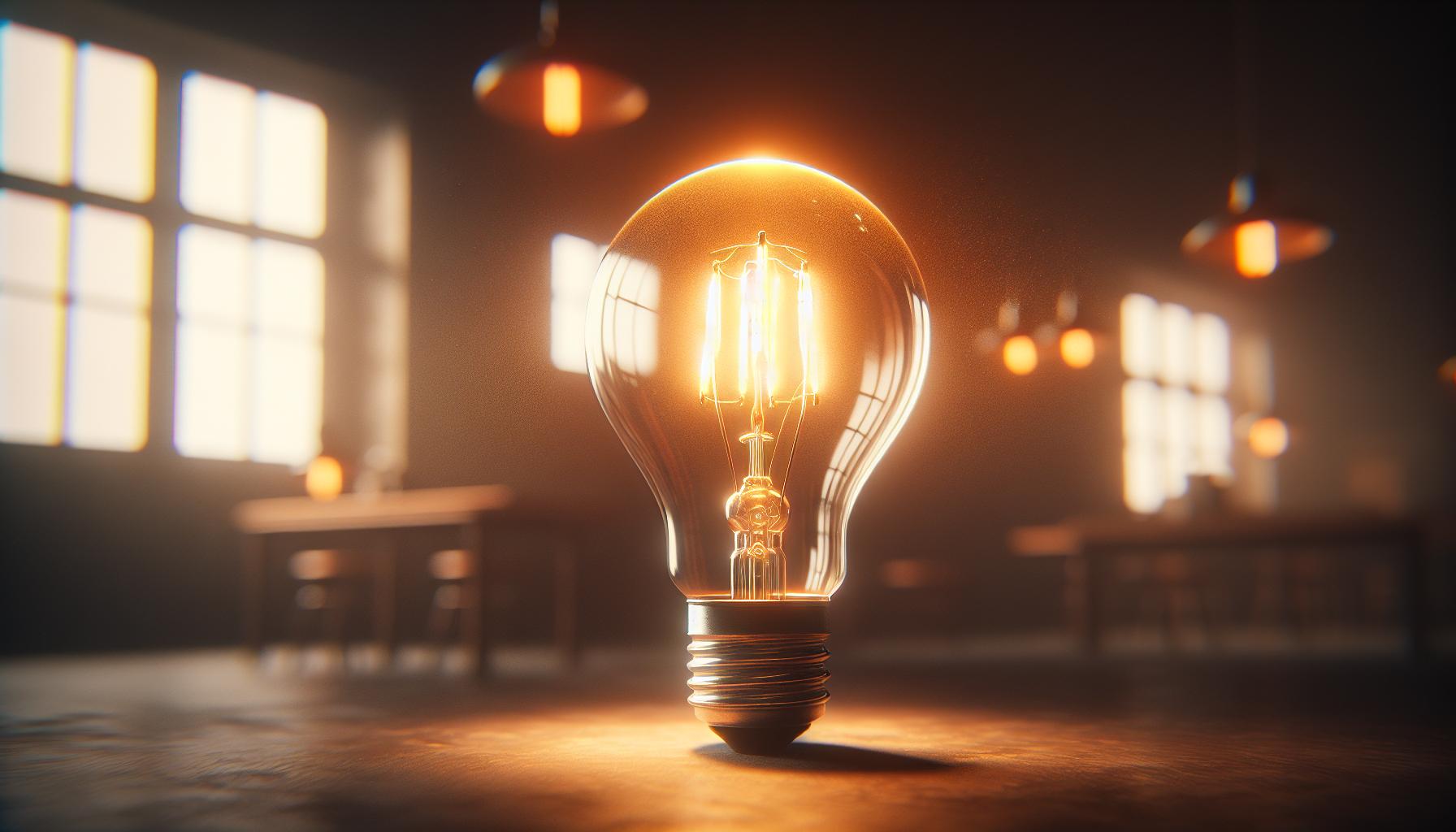Ever wondered why your light bulb doesn’t behave like those neat little resistors you learned about in science class? You know, the ones that follow Ohm’s Law to a tee. Well, it turns out light bulbs are a bit of a rebel in the electrical world.
You might’ve heard the term ‘non-ohmic’ tossed around when talking about the filament in a bulb. It’s a quirky trait that sets these everyday items apart from the straightforward ohmic devices. Let’s dive into what makes light bulbs the mavericks of resistance.
What is Ohm’s Law?
Imagine you’re working on a DIY lighting project. You’ve got your tools ready, and now it’s time to understand the players. Crucial to any such project is knowing Ohm’s Law, the fundamental relationship between voltage, current, and resistance in an electrical circuit. Simply put, this law states that the current through a conductor is directly proportional to the voltage across it and inversely proportional to its resistance.
Ohm’s Law Formula
The expression of this relationship is elegantly simple: I = V/R. In this formula:
- I stands for the current in amperes (A)
- V is the voltage in volts (V)
- R represents the resistance in ohms (Ω)
For all you lighting enthusiasts and home tinkerers, this means that if you know two of these values, you can calculate the third one. Handy, isn’t it? Especially when you’re trying to figure out the right resistor to use with your LEDs or which light bulb can handle a dimmer switch’s altered voltage.
Resistors vs. Light Bulbs: A Comparison
Resistors are components specifically designed to follow Ohm’s Law under almost any circumstance, thus maintaining a constant resistance. They’re the reliable buddies that help you manage the current in your circuit. But light bulbs? They’re the mavericks. As their temperature changes, so does their resistance, in a way that doesn’t quite follow Ohm’s Law.
Key Takeaways about Ohm’s Law
- You must understand Ohm’s Law for any electrical DIY project.
- It simplifies the design and troubleshooting of your circuits.
- Not all components, like light bulbs, adhere to it strictly—this is what distinguishes them as non-ohmic.
So, when working with light bulbs, remember they have a more complex relationship with Ohm’s Law than your garden-variety resistor. Their resistance will change with temperature, affecting how much current they draw. But don’t let this dissuade you; it’s just part of the adventure in DIY lighting endeavors.
Understanding Resistance
When you’re delving into the world of lighting, you’ll quickly find that resistance is the key component that dictates how a light bulb performs. Basically, resistance measures how much a device, like your light bulb, opposes the flow of electric current. Think of it as a rock in a stream; the bigger the rock, the more the water has to work to get around it.
Resistance is not a static feature; in light bulbs, it changes with temperature. When a bulb is switched on, the filament inside gets hot. Really hot. This increase in temperature directly affects the filament’s resistance, generally causing it to rise. Why should you care? Well, this intrinsic property is what sets light bulbs apart from simple resistors.
Here’s the thing: resistors maintain a constant resistance over a wide range of voltages, which means they’re in line with Ohm’s Law—to a point. On the flip-side, you’ve got your average light bulbs that progressively veer away from Ohm’s intuitive predictions. Their resistance increases as they light up, which complicates the relationship between voltage and current.
Understanding this dynamic nature of resistance in light bulbs is crucial, especially when you’re into DIY lighting projects. You wouldn’t want a lighting array that dims unexpectedly or one bulb that shines brighter than the rest, right? For that even glow, choosing the right type of bulb and being aware of how its resistance can fluctuate matters.
Adjusting for a bulb’s changing resistance means knowing the materials it’s made from. Some materials, like tungsten, are favored for their higher melting points and are a staple in incandescent bulbs. But remember, not all bulbs are created equal. LEDs, for example, function with semiconductors and manifest resistance differently than their incandescent counterparts.
« Can You Clean Light Bulbs with Windex? Debunking Myths & Sharing Safe Tips
What Light Bulbs Can Be Used Outside? Discover the Best for Your Yard »
What’s more enthralling is that this variability can be used to your advantage. You can create atmospheres, set moods, and highlight spaces—all by understanding and playing with the resistance of the bulbs. With this knowledge, you’re not just screwing in a light bulb; you’re engineering ambiance.
Ohmic Devices vs Non-Ohmic Devices
Diving into the world of electrical components, you’ll encounter two main types: ohmic and non-ohmic devices. Ohmic devices, as the name suggests, faithfully follow Ohm’s Law, whereby the current flowing through them is directly proportional to the voltage applied across them, keeping the resistance constant. Resistors are the paragon of ohmic devices, often used in circuits to control current or voltage levels. Their predictability makes them indispensable in your DIY toolkit when crafting that perfect lighting setup or tweaking your home electronics.
In stark contrast, non-ohmic devices like light bulbs throw a bit of a curveball. Don’t let this startle you, though; it’s all part of the discovery process. The resistance in non-ohmic devices is not constant and varies with factors such as temperature and current. Take your usual incandescent light bulb, for example. Its resistance increases as it heats up, creating a nonlinear relationship between voltage and current. This dynamic trait is precisely why you find yourself adjusting your project’s design to leverage different bulb types for desired effects.
Semiconductors, too, enter the fray here. They’re akin to wild cards in the ohmic deck, a bit unpredictable but invaluable. Devices like diodes and transistors fall under this category, and you’ve likely come across these when tinkering with light dimmers or making custom LED arrays. Understanding their varying resistance is key to optimizing your projects for efficiency and brilliance.
Let’s not forget the capacitors and inductors. While often overlooked, these components play a crucial role in AC circuits, particularly in those complex lighting designs you love to challenge yourself with. They may not resist current per se, but they do resist changes in voltage and current, adding another layer for you to master.
Zooming back out to the macro level, grasping the distinction between ohmic and non-ohmic devices enhances your creative control. Whether working on ambient lighting for cozy evenings or installing high-intensity work lights, recognizing which components abide by ohm’s law – and which defy it – gives you an edge in designing custom electrical solutions.
Why are Light Bulbs Non-Ohmic?
When you’re knee-deep in a DIY home lighting project, it’s clear that light bulbs are the stars of the show. But have you ever wondered why these essential items behave the way they do? Non-ohmic behavior in light bulbs roots back to the very nature of their construction and operation.
First and foremost, it’s the filament in the light bulbs. Most household bulbs contain a tungsten filament. Tungsten is particularly prized for its high melting point and durability, but it has a quirky trait – its resistance increases as it heats up. When you first turn on a bulb, the filament is relatively cool and has low resistance. As the electric current passes through, the filament heats up, causing its resistance to increase significantly.
This variation with temperature means that the relationship between current and voltage isn’t linear, as Ohm’s Law would suggest. Instead, you’ve got a curve that represents the dynamic changes in resistance. As a light enthusiast and DIYer, you’ll find that using Ohm’s Law to solve for exact values in a circuit with a light bulb can be a bit like trying to nail jelly to the wall – it’s not going to give you the precision you expect.
Moreover, the physical characteristics of the filament play a role. The thinner the filament, the higher the resistance. This is why high-wattage bulbs, with thicker filaments, are generally less resistant when cold compared to low-wattage bulbs.
Another point to consider is the material’s composition. A tungsten filament doesn’t just behave like a straightforward resistor. Current heating the filament also results in a release of electrons – this is thermionic emission. It’s an essential part of how traditional bulbs give off light and an extra layer that separates them from simple resistive devices.
If you’re planning to manipulate lighting for various atmospheres, you’ll want to work with these nuances rather than against them. It’ll allow you to tap into a range of intensities and colors, giving you the creative edge for your lighting projects. Understanding that light bulbs are non-ohmic is just the first step in mastering the art of lighting.
Factors Contributing to Non-Ohmic Behavior in Light Bulbs
You’ve probably noticed that light bulbs don’t behave like your standard resistor, and that’s due to several fascinating factors. Tungsten, the material most commonly used for filaments in incandescent light bulbs, plays a big role in this. Tungsten has a high melting point and can withstand extreme temperatures, but as it heats up, its resistance also rises. This is because the atoms in the tungsten filament vibrate more at higher temperatures, making it harder for electrons to pass through, which deviates from the simplicity of Ohm’s Law.
Physical properties of the filament are also critical. Factors like the length, diameter, and shape of the tungsten filament determine how much resistance is present. A longer filament offers more resistance to the flow of current, while a thicker one allows for more current to pass through. It’s these little details that can drastically change how your light bulb responds when it’s turned on.
Filaments are not perfect conductors, they have a certain structure and constraints. As electricity flows, the filament heats up and causes thermionic emission, where electrons are ‘boiled off’ and released into the vacuum of the bulb. This release of electrons doesn’t happen consistently; it’s more active as the temperature of the filament increases, contributing further to the non-linear current-voltage relationship that defines non-ohmic behaviour.
To top it off, construction variations from one light bulb to another introduce their own quirks to the current and voltage relationship. No two bulbs are exactly alike; tiny discrepancies in material quality, filament winding technique, or even the purity of the vacuum can result in variations of resistance versus temperature among bulbs.
So when you’re working on your next DIY lighting project, keep in mind that the light bulbs you’re using are complex little devices. They’ve got more going on than just lighting up a room; they’re a dance of physics and material science, rising temperatures, and resistance shifts, all contributing to their non-ohmic behavior. Adjusting for these factors can mean the difference between just another light fixture and a tailored ambiance that perfectly matches your space.
Conclusion
You’ve seen how light bulbs present a unique challenge when it comes to Ohm’s Law. Their resistance isn’t static—it dances with temperature, making their behavior a bit unpredictable. But that’s what makes them fascinating, doesn’t it? You now understand that the material of the filament, like tungsten, plays a significant role in this dance and that construction differences can cause variations in how a bulb reacts to current. This knowledge isn’t just technical jargon; it’s a tool for you to create the perfect ambiance or work on lighting projects with a deeper insight into what’s happening behind that luminous glow. Keep this in mind next time you flick a switch, and you’ll see your light bulbs in a whole new… well, light!
Frequently Asked Questions
What is Ohm’s Law?
Ohm’s Law is a fundamental principle in electrical engineering that defines the relationship between current, voltage, and resistance in an electrical circuit. It states that the current through a conductor between two points is directly proportional to the voltage across the two points, inversely proportional to the resistance.
How does Ohm’s Law formula calculate current, voltage, and resistance?
The Ohm’s Law formula expresses the relationship as V = IR, where V stands for voltage in volts, I is current in amperes, and R represents resistance in ohms. To calculate any of these variables, you can rearrange the formula: I = V/R or R = V/I.
Why don’t light bulbs always follow Ohm’s Law?
Light bulbs don’t follow Ohm’s Law rigidly because their resistance changes as they heat up. Unlike resistors, the filament in a light bulb increases its resistance when the temperature rises, leading to a non-linear relationship between voltage and current.
What role does tungsten play in the resistance of light bulbs?
Tungsten is used in light bulb filaments due to its high melting point. As the tungsten filament heats up, its resistance increases. This changing resistance with temperature is a key factor in the non-Ohmic behavior of light bulbs.
How do construction variations affect light bulb performance?
Construction variations among light bulbs, such as differences in filament thickness and shape, can lead to inconsistencies in how resistance changes with temperature. This affects light bulb performance and is important for achieving the desired lighting effects in different applications.
Why is understanding the resistance of light bulbs important?
Understanding the resistance of light bulbs is crucial for managing lighting atmospheres and achieving creative control in lighting design. By knowing how bulb resistance varies with temperature, lighting can be manipulated effectively for various needs and preferences.





